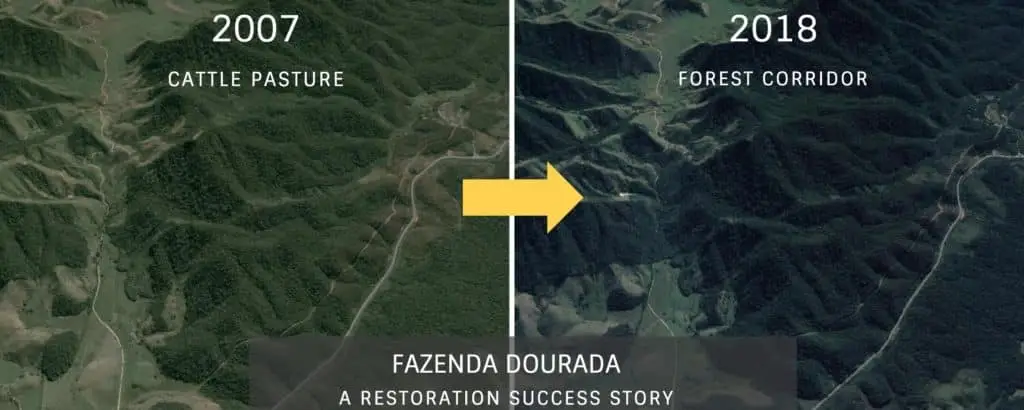Conservation Success
HOW SAVING NATURE MEASURES RESULTS
At the end of the day, it’s results that count – how many acres you have protected, how much carbon you have sequestered, how many species you have rescued from the brink of extinction. In fact, measuring conservation success provides important insights that not only validate our progress, but also strengthen our efforts.
Our projects in biodiversity hotspots around the world have made great strides in protecting the world’s biodiversity and fighting climate change. As a whole, the species protected, forests restored, and carbon sequestered make a difference every day in the health of the planet.
The achievements in preventing the loss of biodiversity, restoring ecosystem health, and improving the quality of life for the local and global communities ultimately define our conservation success. Because our projects have a long-term time horizon, we use progressive measures of success. At a high-level, these statistics show the progress we have made with our portfolio of projects:
13
Projects
43,712+
Species Protected
9,673
Acres Restored
3,160,615
Trees Planted
39,161
Tons CO2 removed per year
CORRIDOR PROGRESS
1. Restoring ecosystem Health
Once we launch a new corridor project, we establish the baseline forest cover. Then, we annually monitor the quality of the landscape, which improves as forests return. Gradually, the forests resume providing “ecosystem services”, such as preventing silting and landslides.
To verify conservation success, our team conducts annual site visits to evaluate reforestation progress. To do so, we use ground surveys, drones, and satellite imagery. Over the long-term, we measure conservation success in completing the corridor connection.
Conservation evidence of the forest
returning can be seen from space
A great example of what we can achieve by strategically reforesting wildlife corridors is our flagship project in Brazil, launched in 2007. Aptly named Fazenda Dourada, meaning golden farm, it was an important connection for golden lion tamarins and other species. A total of twelve years in the making, it has become a functioning wildlife corridor, successfully linking the isolated federal União Biological Reserve to forests to the west and at higher elevations. Today, the corridor and those forests to the west are now included in the much expanded reserve.
Furthermore, the trees have matured into a continuous canopy connecting two forests over a road, creating a migratory pathway. Consequently, endangered golden lion tamarins and potentially thousands of other imperiled species can now travel through previously degraded and fragmented landscapes. Clearly from these Before and After photos, what was once a degraded, impassable landscape for the tamarins and other species is now a passage to more resources.

In 2019, we confirmed the corridor was working, with tamarins crossing into an area from which they had previously been absent. In addition, foxes, crab-eating raccoons, otters, and birds also now live in the corridor.
This corridor has become a model for future restoration projects in Brazil and other biodiversity hotspots around the world.” says Stuart Pimm, President of Saving Nature. “The iconic golden lion tamarin served as the flagship species for this restoration because it’s such a charismatic animal. However, the model will also serve many other unique species.”
2. Mitigating Climate Change
Once reforestation is underway, another measure of conservation success is the carbon sequestration benefits we start to accrue. In fact, each forest we restore adds to nature’s capacity to offset carbon dioxide emissions and fight climate change.
As the trees mature, they soak up at least 12 tons of carbon per acre per year. On average, each US consumer produces about 7 tons of carbon per year. Therefore, it takes less than an acre of forest to offset one person’s carbon footprint for an entire year.
3. Protecting Biodiversity
Movement of wildlife is a critical milestone for validating conservation success, demonstrating the species are repopulating diminished forests, increasing genetic diversity, and improving resilience. Therefore, we have installed a network of camera traps throughout our wildlife corridor to record the species moving through on a 24/7 basis.
We’ve set camera traps along game trails in all of the forests in which we work. Already, they’ve recorded thousands of hours of video that capture unique views of the wildlife we are working to save. Movement and body heat trigger the camera traps to record both photos and videos, day and night.
We compare the species on our camera trap videos with baseline metrics of mammal and bird species in the protected areas that should disperse through the corridor over time. From there, we evaluate project effectiveness based on the diversity of species moving through the corridor over time.
The work of camera trapping is not easy. Sometimes we hike for hours with camera trap strapped around our waists, through mud that sucks off our boots or water that washes into them. Frequently, we struggle through vines entangling our legs, up steep hills on our hands and knees, as insects buzz around us, and snakes lurk on the trails. Often, it’s raining in the tropics and we are frequently drenched. However, the work is important for biodiversity and for the health of our planet, and we miss it when we are home, longing for the buzz of the forest.
As an example of our results, we share here some unprecedented views of wildlife collected throughout our habitat corridors. While you may never venture to these remote forests, you can still experience their wonder.
Copyright 2025 Saving Nature | fGreen Theme powered by WordPress

 Subscribe to our channel
Subscribe to our channel